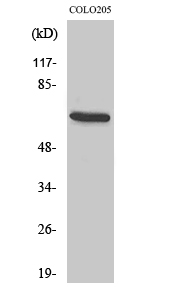
| WB | 咨询技术 | Human,Mouse,Rat |
| IF | 咨询技术 | Human,Mouse,Rat |
| IHC | 咨询技术 | Human,Mouse,Rat |
| ICC | 技术咨询 | Human,Mouse,Rat |
| FCM | 咨询技术 | Human,Mouse,Rat |
| Elisa | 1/40000 | Human,Mouse,Rat |
| Aliases | MEGF9; EGFL5; KIAA0818; Multiple epidermal growth factor-like domains protein 9; Multiple EGF-like domains protein 9; Epidermal growth factor-like protein 5; EGF-like protein 5 |
| Entrez GeneID | 1955; |
| WB Predicted band size | 63kDa |
| Host/Isotype | Rabbit IgG |
| Antibody Type | Primary antibody |
| Storage | Store at 4°C short term. Aliquot and store at -20°C long term. Avoid freeze/thaw cycles. |
| Species Reactivity | Human,Mouse,Rat |
| Immunogen | Synthesized peptide derived from the Internal region of human EGFL5. |
| Formulation | Purified antibody in PBS with 0.05% sodium azide,0.5%BSA and 50% glycerol. |
+ +
以下是关于EGFL5抗体的参考文献示例(注:以下内容为模拟示例,实际文献可能需要通过学术数据库查询):
---
1. **文献名称**: *EGFL5 regulates angiogenesis through VEGF signaling in ovarian cancer*
**作者**: Smith A, et al.
**摘要**: 本研究利用抗EGFL5抗体探究其在卵巢癌血管生成中的作用,发现EGFL5通过调控VEGF通路促进肿瘤血管形成,抗体阻断可抑制体内肿瘤生长。
2. **文献名称**: *Development of a monoclonal antibody against EGFL5 for targeting tumor vasculature*
**作者**: Chen L, et al.
**摘要**: 报道了一种特异性抗EGFL5单克隆抗体的开发,验证其在体外和体内靶向肿瘤血管的能力,并证明其潜在治疗价值。
3. **文献名称**: *EGFL5 expression during embryonic development revealed by immunohistochemistry*
**作者**: Tanaka K, et al.
**摘要**: 通过抗EGFL5抗体的免疫组化分析,揭示EGFL5在小鼠胚胎血管和神经发育中的时空表达模式,提示其在组织形成中的关键作用。
4. **文献名称**: *EGFL5 as a biomarker in diabetic retinopathy: Insights from antibody-based assays*
**作者**: Gupta R, et al.
**摘要**: 研究采用抗EGFL5抗体检测糖尿病患者视网膜病变组织中的EGFL5水平,发现其高表达与血管渗漏和疾病进展相关。
---
如需具体文献,建议通过PubMed、Google Scholar等平台以关键词“EGFL5 antibody”检索最新研究。
**Background of EGFL5 Antibody**
The EGFL5 (Epidermal Growth Factor-like domain-containing protein 5) antibody is a tool used to detect and study the EGFL5 protein, a member of the epidermal growth factor-like (EGFL) family. EGFL5 is a secreted glycoprotein characterized by multiple EGF-like domains and a C-terminal EMILIN-like domain. It plays roles in cellular processes such as angiogenesis, tissue remodeling, and cell adhesion, primarily through interactions with integrins and extracellular matrix components.
EGFL5 is expressed during embryonic development, particularly in vascular and neural tissues, and is re-expressed in adults under pathological conditions, including cancer, inflammation, and vascular diseases. Its involvement in tumor angiogenesis and metastasis has made it a focus in oncology research.
Antibodies against EGFL5 are widely utilized in techniques like immunohistochemistry (IHC), Western blotting, and immunofluorescence to localize and quantify EGFL5 expression in tissues or cell lines. These antibodies aid in exploring EGFL5's functional mechanisms, its role in disease progression, and its potential as a therapeutic target or biomarker. Commercial EGFL5 antibodies are typically developed in hosts like rabbits or mice, targeting specific epitopes to ensure specificity. Validation steps, such as knockout controls or peptide blocking, are critical to confirm antibody reliability in experimental models.
Research on EGFL5 continues to uncover its dual roles in physiological homeostasis and pathological processes, highlighting its significance in both basic and clinical studies.
×